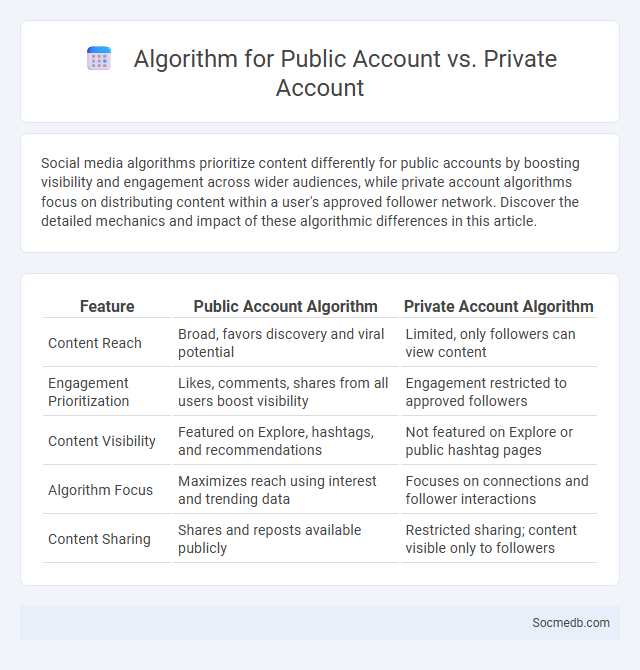
Photo illustration: Algorithm for public account vs Private account
Social media algorithms prioritize content differently for public accounts by boosting visibility and engagement across wider audiences, while private account algorithms focus on distributing content within a user's approved follower network. Discover the detailed mechanics and impact of these algorithmic differences in this article.
Table of Comparison
| Feature | Public Account Algorithm | Private Account Algorithm |
|---|---|---|
| Content Reach | Broad, favors discovery and viral potential | Limited, only followers can view content |
| Engagement Prioritization | Likes, comments, shares from all users boost visibility | Engagement restricted to approved followers |
| Content Visibility | Featured on Explore, hashtags, and recommendations | Not featured on Explore or public hashtag pages |
| Algorithm Focus | Maximizes reach using interest and trending data | Focuses on connections and follower interactions |
| Content Sharing | Shares and reposts available publicly | Restricted sharing; content visible only to followers |
Understanding Public vs Private Accounts
Public social media accounts allow anyone to view and interact with posts, maximizing reach and engagement while sacrificing user privacy. Private accounts restrict content visibility to approved followers, ensuring control over personal information and targeted interactions. Choosing between public and private settings depends on balancing broad exposure with the desire for privacy and security.
How Algorithms Shape Social Media Feeds
Social media algorithms prioritize content based on user engagement, preferences, and behavior to create a personalized feed tailored specifically for you. These complex algorithms analyze factors such as likes, shares, comments, and browsing history to determine which posts appear more prominently, increasing relevance and time spent on the platform. Understanding how these algorithms work can help you curate your feed and control the type of content you see daily.
Public Account Algorithm: Key Features
Public account algorithms on social media prioritize content relevance by analyzing user interactions such as likes, comments, and shares to tailor feeds dynamically. These algorithms leverage machine learning models to identify trending topics and optimize content delivery timing, enhancing visibility for posts with high engagement potential. Personalized content ranking is driven by behavioral data, ensuring that public accounts maintain audience retention and boost organic reach effectively.
Private Account Algorithm: Unique Characteristics
The Private Account Algorithm prioritizes content visibility exclusively for approved followers, enhancing user privacy and control over shared information. It leverages engagement signals within a closed network to tailor content delivery, ensuring your posts reach a highly targeted and trusted audience. This unique characteristic limits exposure to public algorithms, optimizing the experience for users seeking selective sharing and intimate social interactions.
Algorithmic Ranking: How Content Gets Prioritized
Algorithmic ranking on social media platforms determines the visibility of content based on factors like user engagement, relevancy, and recency. Your content is prioritized when it matches a user's interests through machine learning models analyzing past interactions, post types, and user behavior patterns. Understanding these algorithms helps optimize posts for higher reach and better audience targeting.
Visibility Differences: Public vs Private Accounts
Public social media accounts significantly increase visibility by allowing content to reach a broader audience beyond immediate followers, enhancing brand awareness and engagement potential. In contrast, private accounts restrict visibility to approved followers, fostering a more controlled and intimate interaction but limiting content exposure and organic growth opportunities. Users should strategically choose account settings based on desired reach and privacy preferences to optimize social media performance.
Engagement Metrics & Algorithmic Impact
Social media engagement metrics such as likes, comments, shares, and click-through rates are crucial indicators of content performance and audience interaction. Algorithms prioritize content with high engagement by analyzing user behavior patterns, increasing visibility in feeds to maximize platform activity. Understanding these metrics enables marketers to tailor strategies that boost organic reach and foster meaningful connections.
Content Discovery and Recommendation Systems
Content discovery and recommendation systems on social media leverage advanced machine learning algorithms and user behavior analysis to personalize feeds and enhance user engagement. These systems utilize collaborative filtering, natural language processing, and deep learning techniques to predict and suggest relevant content based on individual preferences and social interactions. Effective recommendation engines increase content visibility, improve user retention, and drive platform growth by delivering tailored experiences that match evolving user interests.
User Control and Privacy Implications
User control on social media platforms is crucial for safeguarding personal data and ensuring privacy compliance with regulations like GDPR and CCPA. Your ability to customize privacy settings, manage data sharing preferences, and control visibility of your content directly influences your online security and digital footprint. Understanding these privacy implications helps you prevent unauthorized access and enhances your overall experience in a data-driven social ecosystem.
Future Trends in Social Media Algorithms
Future trends in social media algorithms increasingly prioritize personalized content delivery by leveraging advanced artificial intelligence and machine learning techniques to enhance user engagement and retention. These algorithms will integrate multi-modal data, including text, video, and audio, to provide more contextually relevant recommendations tailored to individual preferences and behaviors. Privacy-centric models and transparent algorithmic processes are expected to become standard, addressing user concerns and regulatory demands while maintaining dynamic content curation.
 socmedb.com
socmedb.com